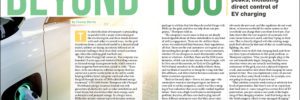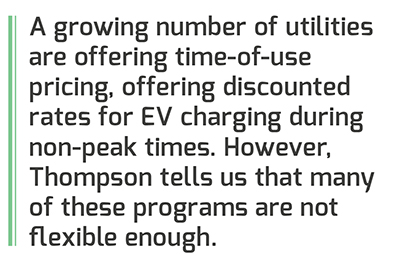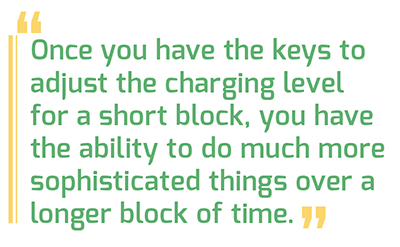
The electrification of transport is proceeding in parallel with a major restructuring of the electrical grid, and these trends interact with each other in several ways. As the grid transforms from a centralized model to a decentralized model, utilities are facing an entirely different set of technical challenges than those that existed a century ago, when the existing grid was built out.
That’s where EnergyHub comes in. The company was founded 12 years ago, and started off building consumer-focused energy management tools, which earned a Time magazine best invention award in 2009. “These days, we’re an enterprise software company that has carved out a pretty useful niche in the utility world, helping utilities better integrate wind and solar into the grid through the use of DERs (distributed energy resources),” CEO Seth Frader Thompson told Charged.
Distributed energy resources include not only generators of electricity such as solar installations and wind farms, but also devices that store energy, such as batteries and pumped storage. In a larger sense, DERs also include various types of dynamic systems that allow utilities to manage the balance between the supply and consumption of energy. Some of these take the form of programs that involve a utility’s customers—for example, the familiar programs under which customers allow a utility to reduce power to certain power-hungry appliances during times of high demand. EV-related programs such as smart charging are a growing part of the mix.
Helping utilities design and manage these types of programs is EnergyHub’s specialty. “We sell a software package to utilities that lets them do useful things with DERs on the grid, and then we help them run programs,” Thompson told us.
“The company’s secret sauce is that we are deeply knowledgeable about all three stakeholders in any kind of utility engagement. There are the utilities themselves: we understand their business, their regulations, all that. There are the end customers: we’re good at understanding how people actually use various products, whether it’s car chargers or smart thermostats or batteries or whatever. And then there are the DER manufacturers, which can include anyone from Google, with its Nest smart thermostats, to Tesla to ChargePoint. We’ve found ourselves in the middle of those three, and we think of ourselves as being the rising tide that lifts all boats, and drives better business outcomes and better customer experiences.
“Back in the early days—five or six years ago—the automakers were just starting to figure out how to even talk to utility companies, and it was like a merging of two industries that never really worked together before. There was a high-level business development problem, but also, all these cars had to plug into all these different systems in ways that they never interacted before, so there were interesting engineering problems as well. It was a good natural fit [for us] to cover both aspects of it.”
Beating the 6 pm power surge
EnergyHub helps utilities avoid simplistic approaches to distribution challenges that may make the problems worse. “Utilities very much like the idea that they can be part of the solution to climate change by helping to electrify transportation,” said Thompson. “But they obviously do not want, and the regulators do not want them, to have to overbuild the entire system so that everybody can charge their cars from 6 to 8 pm. Our data shows that the vast majority of customers will come home between 6 and 8, and they’ll plug in their cars. That is directly aligned with the existing usage peak that’s driven by that end-of-day air conditioning, lighting, etc, mix.”
Utilities want to shift that charging load, and there are three types of solutions to this peak problem, as Thompson explains. “One: you let people plug in the car and immediately begin charging , but then in a situation where you are actually overloading some component of the grid, you run a demand response event, and curtail or slow down that charging for some period of time. Two: you implement a time-of-use rate where you have some fixed window, for example, cars are going to charge from 10 pm to 6 am.”
“That solution certainly works today at relatively low levels of penetration. But there’s sort of an expiration date built into it—once you get to a certain level of EV penetration, you just create a new peak at the beginning of that charging window. And that brings me to the third category, which is true managed charging.”
When a utility has total flexibility in regards to the timing and rate of charging, several different solutions become possible. “You can charge everyone’s car at the same time more slowly, or you can stagger the charging of a couple of cars that are on the same block and then more broadly stagger the charging of cars across an urban area. Or it can be something that’s much more dynamic than that—you can let the whole charging fleet float and follow market conditions, charging when you’ve got clean power available in the middle of the night coming from wind or when you’ve got low-cost power—whatever you’re solving for.”
“All of this stuff comes down to having some constraint on delivering power to the vehicle. That’s either an economic constraint or it’s a system-wide peak constraint, or it’s like a cluster of homes. They’re all on the same transformer and nobody imagined that there were five electric vehicles going to be charging at the same times. You have some constraints, and then you have one of these solutions for time-shifting the charging.
“We are enabling all three, and we structure our work with the utility to give them a path. So, for the utility that just wants to start with enabling time-of-use charging, our engagement starts there, but then everything is flexible about the infrastructure of the program. It doesn’t really matter which of those three models we’re using—customer engagement pieces are flexible, so a utility can start with one model and then work their way through the others.”
Providing more options
A growing number of utilities are offering time-of-use (TOU) pricing schemes, which offer customers discounted rates for EV charging during non-peak times. However, Thompson tells us that many of these programs are not flexible enough. “Just imagine that you’re the communications director at one of these utilities, and you’ve announced that your electric vehicle charging program is 10 pm to 6 am, then 10% of your customers get electric vehicles, and it turns out that that doesn’t work. Now you have to run a new marketing campaign saying, ‘Actually, now we’d like you to charge from midnight to 6 am,’ or whatever.”
“The average customer is plugging in their car between 10 and 12 hours per night, but the car only charges for about two of those hours, so you have this tremendous flexibility so long as you do two things. First, give the customer a full charge by the next time they need it. Second, be genuinely flexible about when that next time is that you need it. If it’s someone who’s coming home from work and then they’re not going to unplug the car until morning, you’re good as long as you’re charged by morning. But somebody who comes home at 6 pm and needs to leave the house again at 7 to go out to dinner needs to be able to say, ‘No, I need to charge the car right now.’

“Providing flexibility is important. Consumer behavior is crucial here, and everything we do is opt-in. Utilities encourage customers to participate by offering a package of incentives, typically a cash gift for signing up, and then some ongoing incentive such as a lower charging rate.
“One of the most fascinating things is that customers’ impressions of their utilities tend to improve through these programs. A customer signing up to be flexible is committing themselves to being part of a solution, and the utility is now associated with this modern brand of EV infrastructure and with smart clean technology. So, what we see is that customers sign up, they stay signed up and they’re not super-picky about what they sign up for. Our role tends not to be public, but in general what we see is that between 20% and 40% of customers who receive an offer to join one of these programs will sign up for it. That’s off the charts in terms of standard customer engagement.”
We have assumed control
One existing application of EnergyHub’s system is a program that was launched a few months ago with Eversource, a Massachusetts utility that serves over three million residential customers. “It’s one of the first programs that managed EV charging programs with actual control of devices,” says Thompson. “The program is set up to be open to any charger or vehicle, so you can bring a ChargePoint charging station or you can bring an EV that’s got onboard telematics, and [the program will] let you control it remotely.”
“It is actual direct control, direct throttling of the charger. It’s pretty open-ended on what [Eversource] can do. Their intent is to start with demand response—essentially curtailing charging when there is an actual system emergency. But we’ve set up the program so that they have a lot more capability than that—once you have the keys to adjust the charging level for a short block, you have the ability to do much more sophisticated things over a longer block of time.”
In this program, utility customers don’t specify the exact times charging will occur. Rather, the system learns their habits. “There is a lot of technical sophistication behind the scenes: machine-learning AI stuff that learns what the customer’s habits are. The customers understand that they are signing up to provide flexibility to the utility and how the charging occurs and there’s an implicit level of trust that that’s not going to screw up their lives in some way.”
“However, what we always keep in mind is that, when the customer leaves for work, the car needs to be charged. If the customer says, ‘I need the charge right now,’ you need to charge them right now.” Customers can always bypass the system if they absolutely need to charge their cars. “There is an override button, and they can use it no matter how often they want. That is the thing that gets customers comfortable that there’s nothing to lose.”
Utilities have been running similar programs that control heating or AC equipment for years, and EnergyHub has a lot of data about customer behavior. “We find that a small number of customers override on any given day, and those that do override on one day are very unlikely to override again the next day. We’re often asked by utilities, do people game the system, take the incentive and then always override? The data shows that people do not do that. And this is across hundreds of thousands of participating customers across the US.”
“When you ask people, ‘Why are you participating in this program?’ the answer is usually, ‘I am always in control at the end of the day and this is good for the grid, good for the environment and good for me. So why would I not do it?’”
The invisible hand
What will a future EV charging system look like? A clue might be the example of smart thermostats, which Seth says already represent “thousands of megawatts of aggregate load under management. Smart thermostats are the biggest, but we also do water heaters and batteries and solar, and each of those are effectively invisible unless you screw up.”

“Utilities tend to think of the aggregation as a program, which represents a resource of let’s say a hundred megawatts of flexible load. And depending on what’s in that resource, they’ll use it for different things at varying frequency. A typical smart thermostat program might get called 10 to 20 times a year. A utility that’s gotten really comfortable using it or that has really tough operating conditions might call 20 to 30 events per year, and each time that happens the temperature goes up in your house.”
According to Seth, participation rates for such “invisible” DERs are over 90 percent, because most of the time customers don’t notice them. “Why would you ever know that anything is going on, unless the shower is cold or your car isn’t charged?”
EVs: the new frontier
“One of the hardest things from a utility perspective, if you’re reaching very high levels of wind and solar, is that the grid is now much more dynamic,” says Thompson. “Utilities are looking for loads and uses of power that are equally dynamic, and EVs are really the perfect resource for that. What’s exciting about EVs is that, so long as the customer wakes up to a car that’s fully charged, you have this ability to flex the charging time every day or every time the car is plugged in.”
“Obviously residential charging is mostly at night, but when you do workplace charging, you’ve also got a daytime resource. And then when the utility has the ability to aggregate across DERs, you can mix in thermostats, solar-integrated batteries and EVs, and you have this 24/7 load resource that’s much more dynamic, and can respond to whatever kind of weird things are happening with your wind and solar on the grid.
“EVs are probably what we are most excited about as a business. The fact that you have a few dozen new electric vehicles about to come on the market, and all this new EV infrastructure being built out at the same time as you’re trying to decarbonize the grid, just makes it a very exciting time.”
This article appeared in Charged Issue 48 – March/April 2020 – Subscribe now.
source https://chargedevs.com/features/energyhub-gives-utilities-more-flexibility-to-manage-peaks-including-direct-control-of-ev-charging/
No comments:
Post a Comment